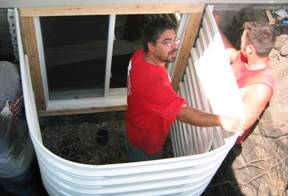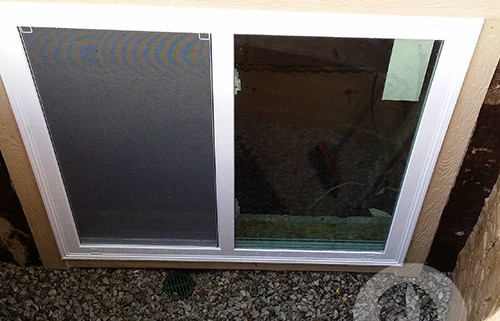Code Requirements For Basement Egress Windows
The purpose of this blog is to educate you on the building code requirements for egress windows in finished basements. Kansas City and most of the local surrounding municipalities use the IRC (International Residential Code) as a guideline for building safety & quality. They have specific guidelines that the Kansas City metropolitan area follows.
In previous blogs, we have discussed the benefits of having 1 or more EGRESS WINDOWS in your full in ground basement. Here is a quick summary of the benefits:
- ADDS VALUE TO YOUR HOME

- ADDS SAFETY
- ADDS COMFORT
- MEETS CODE
INTENT OF THE LAW?
The intent of the code is to give you a means of escape from the basement. The code assumes that if the basement has living space, that you will be in this space more often than if it was just a basement. An egress window will also allow access for a firefighter to gain entrance. The code gets updated every 3 years.
Egress: 1. The act of leaving, or the right or freedom to leave, departure. 2. A means of going out or leaving, an exit, an outlet.
WHERE DO YOU NEED TO HAVE AN EGRESS WINDOW? (or door)
They are required in every habitable space, such as sleeping rooms, dens, media room, office, or gym. Each of these rooms will need it’s own window or door for escape. Smaller rooms such as closets or bathrooms do not need an egress window, or door.
BASIC EGRESS WINDOW REQUIREMENTS
- The bottom of the window can’t be more than 44″ off of your basement finished floor
- The minimum opening area must be at least 5.7 square feet
- The minimum window height is at least 24″
- The minimum window width is at least 20″
BASIC EGRESS WELL REQUIREMENTS
- The distance from the window to the back of the well must be at least 36″
- The minimum area of the well must be at least 9 square feet (width x projection)
- The well must not interfere with the window being able to open fully
- You must have a ladder or steps to get out of the well, if the well is more than 44″ deep on the inside
- The steps or rungs must not be more than 18″ apart
- The steps or rungs must project away from the well at least 3″
BASIC EGRESS COVER OR GRATES REQUIREMENTS
- Covers are not required, and are optional.
- They should be easily removed without the use of any tools.
So, if you plan on finishing off your basement in the Kansas City area, you will need to consider adding a means of escape to each of your habitable rooms.
HERE IS THE ACTUAL COPY OF THE CODE TAKEN FROM THE IRC CODE BOOK
R310.1 Emergency escape and rescue required. Basements, habitable attics and every sleeping room shall have at least one operable emergency escape and rescue opening. Where basements contain one or more sleeping rooms, emergency egress and rescue openings shall be required in each sleeping room. Where emergency escape and rescue openings are provided they shall have a sill height of not more than 44 inches (1118 mm) above the floor. Where a door opening having a threshold below the adjacent ground elevation serves as an emergency escape and rescue opening and is provided with a bulkhead enclosure, the bulkhead enclosure shall comply with Section R310.3. The net clear opening dimensions required by this section shall be obtained by the normal operation of the emergency escape and rescue opening from the inside. Emergency escape and rescue openings with a finished sill height below the adjacent ground elevation shall be provided with a window well in accordance with Section R310.2. Emergency escape and rescue openings shall open directly into a public way, or to a yard or court that opens to a public way.
Exception: Basements used only to house mechanical equipment and not exceeding total floor area of 200 square feet (18.58 m2).R310.1.1 Minimum opening area. All emergency escape and rescue openings shall have a minimum net clear opening of 5.7 square feet (0.530 m2).
Exception: Grade floor openings shall have a minimum net clear opening of 5 square feet (0.465 m2).R310.1.2 Minimum opening height. The minimum net clear opening height shall be 24 inches (610 mm).
R310.1.3 Minimum opening width. The minimum net clear opening width shall be 20 inches (508 mm).
R310.1.4 Operational constraints. Emergency escape and rescue openings shall be operational from the inside of the room without the use of keys, tools, or special knowledge.
R310.2 Window wells. The minimum horizontal area of the window well shall be 9 square feet (0.84 m2), with a minimum horizontal projection and width of 36 inches (914 mm). The area of the window well shall allow the emergency escape and rescue opening to be fully opened.
Exception: The ladder or steps required by Section R310.2.1 shall be permitted to encroach a maximum
of 6 inches (152 mm) into the required dimensions of the window well.R310.2.1 Ladder and steps. Window wells with a vertical depth greater than 44 inches (1118 mm) shall be equipped with a permanently affixed ladder or steps usable with the window in the fully open position. Ladders or steps required by this section shall not be required to comply with Sections R311.5 and R311.6. Ladders or rungs shall have an inside width of at least 12 inches (305 mm), shall project at least 3 inches (76 mm) from the wall and shall be spaced not more than 18 inches (457 mm) on center vertically for the full height of the window well.
R310.3 Bulkhead enclosures. Bulkhead enclosures shall provide direct access to the basement. The bulkhead enclosure with the door panels in the fully open position shall provide the minimum net clear opening required by Section R310.1.1. Bulkhead enclosures shall also comply with Section R314.9.
R310.4 Bars, grills, covers and screens. Bars, grills, covers, screens or similar devices are permitted to be placed over emergency escape and rescue openings, bulkhead enclosures, or window wells that serve such openings, provided the minimum net clear opening size complies with Sections R310.1.1 to R310.1.3, and such devices shall be releasable or removable from the inside without the use of a key, tool, special knowledge, or force greater than that which is required for normal operation of the escape and rescue opening.
R310.5 Emergency Escape Windows under Decks and Porches. Emergency escape windows are allowed to be installed under decks and porches provided the location of the deck allows the emergency escape window to be fully opened and provides a path not less than 36 inches (914 mm) in height to a yard or court.




